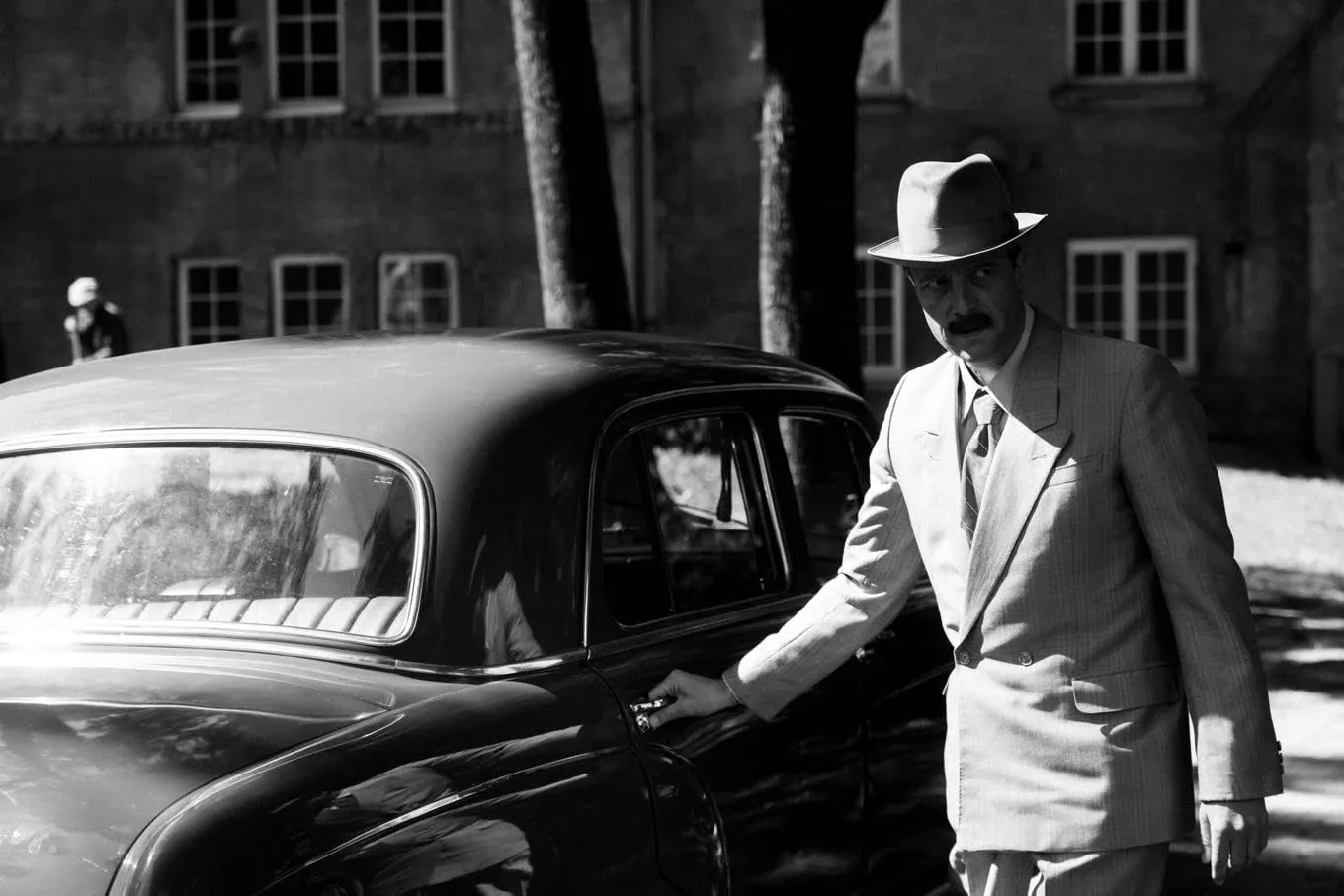The Disappearance of Josef Mengele emerges as a specter of history, directed by Kirill Serebrennikov from Olivier Guez’s novel, with August Diehl inhabiting the infamous physician’s haunted silhouette. We first glimpse Mengele’s bones under bright dissection lights in a present-day Brazilian classroom, then slip into black-and-white corridors of his fugitive life—Argentina, Paraguay, Brazil—each locale tinted by fear and memory. Diehl, unrecognizable beneath prosthetics, becomes a vessel for a man who once sought genetic “purity” yet now hunts anonymity under ever-shifting aliases.
The film unfolds like a fractured mirror: noir-tinged thriller, character study, moral reckoning. Stark monochrome gives way to one vivid flashback in color—an eruption of Auschwitz horror that jolts both eye and conscience. Serebrennikov’s camera, often trailing Mengele from behind, traces the cruel geometry of his obsession and the chasm between his grand vision and every-day human dread.
Expect an exploration of narrative architecture, performances that blur compassion with revulsion, and a probe into the ethics of depicting atrocity on screen—an interrogation of how film can both reveal and betray historical truth.
Echoes of Exile: Narrative Structure & Pacing
Three on-screen captions divide the tale by Mengele’s pseudonyms—each chapter a breathless pivot from Argentina’s sunlit estates to Paraguay’s dusty outposts, then Brazil’s humid hinterland and a clandestine German homecoming.
A forensic prologue in 2023 bookends the main timeline (1950s–1970s), while intermittent color flashbacks to camp life shatter the monochrome illusion. These temporal shifts sometimes fracture coherence—yet they also mirror a mind splintered by guilt and denial.
Moments of sleek suspense—the stealthy border crossing into Germany, the Perón-era wedding’s hushed alarms, the Stammer farmhouse’s uneasy hospitality—rise like waves before receding into quieter terrain: domestic dinners, furtive medical exams, the son’s 1977 pilgrimage to São Paulo.
At its swiftest, the film races through arrest warrants and narrow escapes; at its most introspective, it lingers on a weary face, the tremor in a lifted glass. Uneven pacing can jar, but in those jolts lies the breath-holding tension of a life perpetually unmoored.
Faces of Denial: Performances & Character Dynamics
August Diehl disappears into Mengele’s gaunt frame, his voice low-toned and measured until bursts of fury rend the silence. Under layers of old-man makeup, menace simmers—his posture a testament to lifelong entitlement, his eyes flickering between self-justification and mounting paranoia. Opposite him, Max Brettschneider’s Rolf brings a fragile innocence: hope that curdles into disillusionment as his father’s logic unspools.
Burghart Klaussner’s father and Dana Herfurth’s Irene inhabit the margins, their brief appearances casting long shadows of inherited ideology and domestic normalcy warped by atrocity. Annamaria Lang and Tilo Werner, as the Stammers, offer hospitality laced with simmering resentment—every polite gesture a reminder of complicity.
In the Argentina chapter, Friederike Becht’s Martha floats like a specter of socialite elegance, her grace ill-matched to the horrors beneath. Together, these interactions expose the widening chasm between Mengele’s self-image and the grim reality around him, a dance of false civility cracking at the edges.
Canvas of Horror: Cinematic Craft & Thematic Depth
Vladyslav Opelyants’s lens drenches the narrative in stark blacks and whites, where shadows feel like living tendrils wrapping Mengele in relentless scrutiny. Long takes stretch time into taut wires of suspense; punctuated only by the sudden bleed of color in the Auschwitz flashback, a cruel incision that forces us to confront the raw stain of atrocity. Production design—from Perón-era ballrooms to weathered Brazilian farms—anchors the fugitive network in unsettling realism, while each costume and prop whispers of a community that refused to vanish.
Ilya Demutsky’s score—dissonant strings and ominous horns—threads through the film like a pulse, marking each heartbeat of dread. Editing shifts eras and perspectives almost like shards of fractured memory: sometimes harmonious, sometimes jagged, but always echoing the film’s central tension between history as myth and memory as accusation.
Philosophically, the film plumbs questions of impunity and collective guilt: how fascist networks thrive long after defeat, sustained by silence and selective amnesia. Memory versus myth unfurls in Rolf’s desperate quest for truth against his father’s chilling rationalizations.
And in choosing to show graphic camp imagery, the film teeters between ethical witness and sensational spectacle—an ethical knife-edge as fragile as conscience itself. Does Serebrennikov’s austere style illuminate the darkness, or risk aestheticizing horror? The answer pulses like a question without easy solace.
The Disappearance Of Josef Mengele had its world premiere at the Cannes Film Festival on May 20, 2025, in the Cannes Premiere section.
Full Credits
Director: Kirill Serebrennikov
Writers: Kirill Serebrennikov (screenplay), based on the book by Olivier Guez
Producers: Charles Gillibert, Ilya Stewart, Julio Chavezmontes, Mélanie Biessy, Christopher Cooper, Abigail Honor, Yan Vizinberg, Felix von Boehm
Cast: August Diehl (Josef Mengele), Max Bretschneider (Rolf Mengele), Dana Herfurth (Irene Mengele), Friederike Becht (Martha Mengele), Mirco Kreibich, David Ruland (Hans Sedlmeier), Annamária Láng (Gitta Stammer), Tilo Werner (Geza Stammer), Burghart Klaußner (Mengele’s father)
Director of Photography (Cinematographer): Vladislav Opelyants
Editor: Hansjörg Weißbrich
Composer: Ilya Demutsky
The Review
The Disappearance Of Josef Mengele
Serebrennikov’s The Disappearance of Josef Mengele is a haunting odyssey through guilt and denial, its stark monochrome beauty pierced by jolting color memories of Auschwitz. August Diehl’s steely transformation and the film’s moral inquisitions linger long after the credits roll—even as uneven pacing and moments of sensational shock undermine its loftiest ambitions. This is cinema that dares to confront evil’s afterlife, asking whether art can bear witness without exploitation.
PROS
- August Diehl’s chilling, fully committed portrayal
- Vladyslav Opelyants’s stark black-and-white cinematography
- Ilya Demutsky’s dissonant score that underpins tension
- Thought-provoking exploration of impunity and memory
- Sudden color flashback that jolts the viewer’s conscience
CONS
- Uneven pacing across its three-chapter structure
- Graphic Auschwitz scenes verge on sensationalism
- Some supporting characters remain under-fleshed
- Temporal jumps can fragment emotional engagement
- Ethical tension sometimes gives way to stylistic excess
